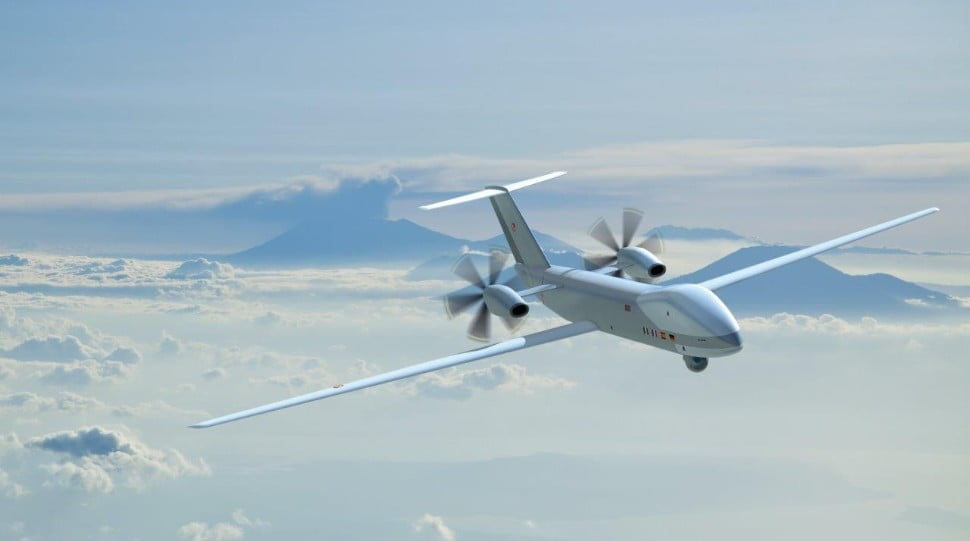By Pierre Tran
Paris – OCCAR, a European procurement agency, signed Feb. 24, 2022 a contract worth €7.1 billion ($8 billion) with Airbus Defence and Space as prime contractor for a medium-altitude, long-endurance drone, marking a step in the European pursuit of military, industrial, and political independence.
“The Eurodrone program aims to deliver a sovereign capability in intelligence, surveillance and reconnaissance, support for ground forces in a theater of operation and attack, having capability to fire missiles and guided bombs,” the French armed forces ministry said Feb. 25 in a statement.
The launch of the program “marks a key step in the strengthening of European cooperation,” the ministry said. The order, worth €7.1 billion, covered developing and building 60 drones, with 12 for France, and five years of service.
OCCAR signed on behalf of the four partner nations – France, Germany, Italy and Spain – for Airbus DS to develop, build and maintain an unmanned aerial vehicle.
The UAV was expected to be certified to operate in civilian airspace in Europe and fly as part of the European Future Combat Air System, a complex network with a new generation fighter and remote carrier drones.
“This is important,” said François Lureau, “as it is the precondition for FCAS. It is a European program led by Germany. Lureau is head of consultancy EuroFLconsult and a former head of the French procurement office.
The political significance of the program could be seen in the German chancellor referring to the drone contract in a Feb. 27 keynote speech, in which Olaf Schulz said Berlin would commit €100 billion to the German defense budget this year, up from €47 billion in 2021, and pledged to spend two percent of gross domestic product on the military by 2024.
That speech marked a sharp change in German policy in the light of the Russian invasion of Ukraine, with Berlin pledging to send 1,000 anti-tank weapons and 500 Stinger anti-aircraft missiles to the Ukraine forces.
Europe Seeks To Catch Up
The drone program would allow Europe to break a dependence on Israel and the U.S., allowing European industry to learn how to build a MALE UAV from scratch, an industry executive said. Although the first aircraft will likely be less capable than the Reaper, the foundations would be laid for a long term industrial capability for future European drones.
A second executive said the Ukraine crisis showed the prospect of “long term tension in Europe,” leading to the launch of an arms drive in Western Europe.
France needed to equip its forces for a “high intensity” conflict in Europe, as the army, apart from the Tiger attack helicopter and VBCI armored personnel carrier, was largely armed for overseas deployments in Africa, with wheeled armored vehicles rather than heavy tanks.
“There has been a change of software,” the second executive said.
On the military aspect, German forces launched attacks which led to the killing of civilians in the war in ex-Yugoslavia, the first executive said. Those slayings stemmed from the German forces relying on summaries of US intelligence rather than access to raw intelligence data and making their assessment. That led to Berlin launching the SAR-Lupe radar spy satellite program to cut that dependence.
Allied nations share summaries of intelligence, not the raw intelligence data, which pointed up the importance of gathering the data, assessing and then deciding the operations, the executive said. Cooperation among allies with independent ISR systems offered a “complementarity” of threat assessment.
France is updating its intelligence gathering capability with a three-strong fleet of new generation optical spy satellites, dubbed Composante Spatiale Optique. A second CSO satellite was put into orbit Dec. 29 2020, at a height of 480 km, to give sharp resolution. Belgium, Italy, Germany and Sweden signed bilateral agreements for access to CSO.
CSO replaces the French Helios spy satellite, intended to cut reliance on the U.S.
In the first war with Iraq, the Helios system may have lacked the sharpness of the then six-strong American fleet of satellites, but France had an independent capability which led them to disagree with the U.S. assessment of the strength of the Iraqi army, afternoon daily Le Monde reported in 1996.
Spain and Greece are partners on the Helios program.
France Gradually To Retire Reapers
On the European drone, France has ordered four systems, with options for two more, the ministry said. A system consists of three drones and two ground stations. The new drones will gradually replace the fleet of Reapers, which will start to be retired from service after 2030.
Building the first prototype was due to start in 2024, the ministry said.
Development was due to run for four years, a third industry source said, with first flight due in 2026, and first delivery toward the end of 2028.
The UAV project took time to win governmental approval, as the lead contractor Airbus had made an initial budget estimate of some €10 billion and had to cut the price to an amount seen as acceptable.
Dassault Aviation and Leonardo are subcontractors on the program.
“This signature kicks off the development of one of the most ambitious European defense programs,” Mike Schoellhorn, chief executive of Airbus Defence and Space, said in a statement.
Eric Trappier, chief executive of Dassault, said, “This contract marks the determination of the European nations and industrial partners to achieve the political goals and to meet the technological challenges leading to European defense sovereignty.”
“Today’s announcement marks an important milestone for the European nations which confirms the determination and achievements of the industrial partners in meeting the challenges that accompany the development of a complex and strategic European defense and security program, said Lucio Valerio Cioffi, general manager of Leonardo.


